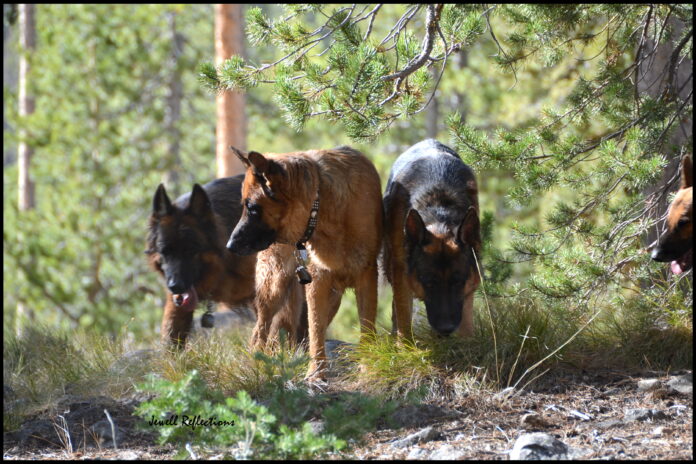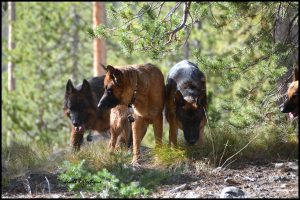
BY FRAN JEWELL

I can remember in seventh grade learning about the caste system in India and being appalled at the social rank people accepted. I grew up in a household where my sisters and I were encouraged to follow our dreams and we treated all races and genders equally.
Now, as a certified dog-behavior consultant, I spend every day, all day, observing and living with dog behavior. But, of course, I watch bird behavior and any other animal I can get a glimpse of because animals are my passion.
I tried to swallow the new beliefs called “science-based” dog behavior that debunk the existence of the dog pack and claim that domestication has removed all evidence of the canine social hierarchy.
Having lived with over 30 German shepherds over the years, I have learned to re-accept the existence and requirements of the dog pack and social hierarchy.
There is one dog in my household that all visiting dogs go to, either to challenge him or to lick his lips. That is Brinx. Every puppy goes to him first and tries to climb on him, then learns to lick Brinx’s lips as an honoring gesture.
There simply is no way to explain dog behavior until you understand and accept dog-pack dynamics.
As I see it, dog social structure is much like the military and visually like a pyramid. The high-ranking dog is like a general; they are few and far between. They are completely knowledgeable, confident, and give directions. They never fight. They are calm and even a look can control all the dogs in their vicinity, as if every other dog recognized a uniform and stars on his or her shoulders.
At the bottom of the pyramid are all the enlisted dogs, or privates. They do all the work. They are happy to do what they are told and don’t usually, if ever, challenge authority.
Then there are the mid-ranks—the lieutenants, sergeants, etc. They give orders, but they recognize those that are of a higher rank than they are, always yielding to higher authority.
What confuses us is that we think that if our dog is “higher ranking,” he or she is higher ranking than all the other dogs. We don’t often understand why a high-ranking (notice I don’t say alpha) dog would yield to another dog. The answer is simple. We humans don’t always know the rank of our dog and can’t see the “uniforms” like dogs do. We don’t understand how one minute our dog seems to be the authority, but the next might submit to the authority of another dog. We don’t understand or often recognize their challenges to each other to explore rank. And, often we brush off critical social interactions, calling them something else. Frequently, we humanize their behaviors, which makes no sense.
When we are confused, usually our dogs are confused as well. Social—or dominance—confusion, as I call it, is the primary reason for aggression. When a dog is puzzled about his status, he can become defensive or fear aggressive. The ambitious dog might take that as an open door to move up in social rank. Our confusion about their pack order or social rank can be the reason for aggression.
Most dogs, due to domestication, have learned to look to us for direction. When we don’t provide direction, many dogs become nervous or anxious and, consequently, can become defensive. The ambitious dog will take advantage.
Understanding and accepting that dogs must have social structure, just like every other species on the planet (even humans), is the first step to having a peaceful dog that is happy and well adjusted.
Fran Jewell is an Idaho Press Club award-winning columnist, IAABC-certified dog behavior consultant, NADOI-certified instructor #1096 and the owner of Positive Puppy Dog Training, LLC, in Sun Valley. For more information, visit positivepuppy.com or call (208) 578-1565.
